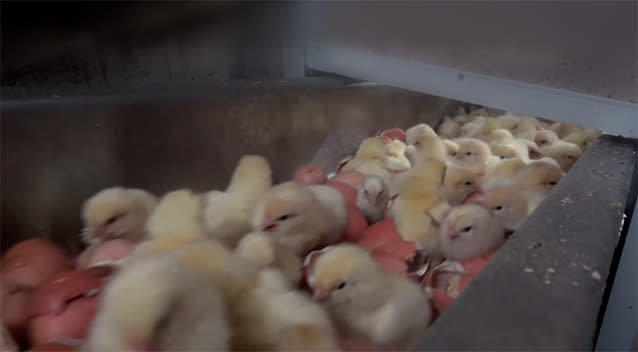Culling of male chicks in hatcheries, a by-product of the egg industry, is usually done within the first day of a chick's life after so-called "sexing". Each year, hatcheries kill around 330 million male day-old chicks in the European Union, because producers do not find rearing them financially efficient due to roosters growing up at a much slower pace compared to broiler chickens.
The most common methods of chick culling include maceration and carbon dioxide gassing (as permitted by the Council Regulation No 1099/2009 on the protection of animals at the time of killing).
The most common methods of chick culling include maceration and carbon dioxide gassing (as permitted by the Council Regulation No 1099/2009 on the protection of animals at the time of killing).
Alternatives to chick culling
Α
Technology can identify the sex of a chick while still in an egg, making it possible to prevent the male chick from hatching and sparing it of a cruel death. It is still debated when exactly a chicken embryo starts to be able to perceive pain. Researchers believe they are able to do so from the 15th out of 21 days of incubation, although today, the use of specific methods can achieve results in a shorter period of time.
The technology to find out the sex of a chicken embryo before hatching is already available on the market. Examples include:
- Seleggt (Germany). This technology makes it possible to recognize the sex of an embryo on the 9th day of incubation based on hormones. Once the male sex is recognized, incubation process is stopped, and eggs can be used as feed.
- Ella (The Netherlands). This high-throughput screening machine is capable of gender typing eggs on the 9th day of incubation.
- CHEGGY (Germany). It is based on the detection of the feather colour. The technology is suitable for large production and is currently the most cost-efficient process on the market. However, it detects the sex of a chick on the 13th day of the incubation period, when an embryo already resembles a chick.
- EggXYT (Israel). This method works on the basis of genetic marking of the sex chromosomes, using UV light. Unlike the first three technologies, this one makes it possible to detect the sex right after the eggs were laid, that is on day zero of incubation. However, the genetic interference might turn out to be a problem for the European market.
Β
Keeping the male chicks and raising them as roosters for meat production. However, that is usually not profitable for the industry as it takes roosters four times longer to reach the slaughter weight than it takes broiler chickens. Moreover, stopping the incubation and preventing chicks from hatching is:
- more ethical that keeping them for further rearing and eventual slaughter
- more sustainable as these roosters need a longer time to grow, their feed demands are therefore higher and so is their overall impact on the environment. Animal production and the numbers of animals kept for food production need to be decreased, not the opposite.
There is also a possibility of breeding dual-purpose chickens (females for egg laying, males for meat production). Dual-purpose breeds tend to produce less females lay significantly fewer eggs and males gain weight much more slowly than fattening chickens.
The first two countries in the European Union to ban male chick culling are Germany and France, both prohibiting the practice from 2022.

During the EU Council meeting in July 2021, Germany and France with support from Austria, Ireland, Luxembourg, Portugal and Spain called on the ban on chick culling to be introduced across the EU.
Very recently, the Italian Chamber of Deputies (the lower house of the Parliament) approved a law prohibiting male chick culling by the end of 2026.
Very recently, the Italian Chamber of Deputies (the lower house of the Parliament) approved a law prohibiting male chick culling by the end of 2026.
A glimpse of hope
There are also private initiatives labelling eggs based on the criterion of no chick culling. Examples could include respeggt, which slowly becomes a consumers’ favorite.
Chicken culling must be stopped today. It is up to us to make it happen.
